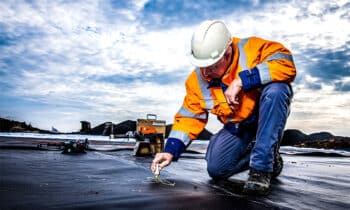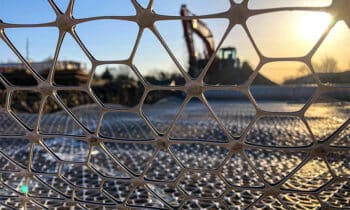
Vertical drainage can be biobased from now on
Vertical drainage is a household word in the Netherlands. For more than 50 years, Cofra has been a pioneer in the development of this consolidation technique to rapidly settle soil. What once began with paper drains quickly evolved into plastic ones, of which many hundreds of millions of meters have now been successfully used worldwide. With the BioDrain, Cofra is taking the next step: vertical drainage can now also be biobased.
Cofra's plastic drains are unequaled in terms of functionality. The product has been fully developed over the past decades and is used everywhere in the Netherlands and far beyond. "The only disadvantage to this type of drain is that it is basically a petroleum product," says Wiegert Dijkkamp, project manager at Cofra Netherlands. "We therefore started developing an alternative five years ago. And that turned out to be a quest of years. This is because the BioDrain consists of a core and a filter. The filter is based on lactic acid and is readily available. However, the big trick lies in fine-tuning the 'recipe' of the core material in such a way that we can also produce the bio-based replacement on a large scale in-house."
At least equivalent
The starting point in developing the BioDrain, according to Dijkkamp, was to develop an equivalent drain with at least the same specifications. "That is, with the same dimensions, drainage capacity and tensile strength as the plastic drain," he clarifies. "And we more than succeeded. Even the look and feel is similar. You do have to be a real insider to recognize the biobased version." After many internal tests, both on a laboratory scale and outside in the field, Cofra successfully applied the BioDrain to a "real" project for the first time last summer. "All credits to Alliantie Markermeerdijken who gave us the opportunity to 'test' the BioDrain on the large-scale dike reinforcement task. Here we performed two sections side by side with the BioDrain on the one hand and the regular MebraDrain on the other. This also involved a monitoring process. And the result is satisfactory: the functionality of the BioDrain is at least equivalent to the regular drain, and to be honest even slightly better."

Innovating in steps
So the BioDrain is functionally better than the plastic drain. That's not necessarily an advantage, Dijkkamp acknowledges. "In terms of design, it is not necessary. On top of that, the raw materials and production process for the BioDrain are more expensive than for the regular drain. So a client really has to (be) motivated to choose this drain. So we are not there yet. Because not only in design there are still optimizations to be achieved, also in the choice of raw materials. The current BioDrain breaks down completely into non-harmful substances in an industrial composting process, which has now been demonstrated by a certified institute and is important to us. Indeed, as a soil improvement specialist, our ambition is to eventually develop a drain in a non-soil product and in a completely sustainable production process. However, we believe that innovation in the chain works better in steps. And with the BioDrain we are already a long way in the right direction in terms of product."
The BioDrain has the OK Biobased 3-star label. The MKI value will probably be issued by the end of the year, so that choosing a sustainable alternative will also be rewarded in a more favorable EMVI score. Cofra produces the BioDrain not only for its own use, but, like the regular drains, also for third parties.




